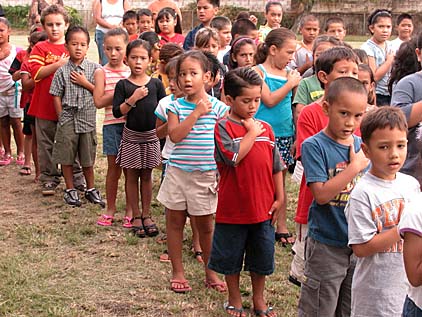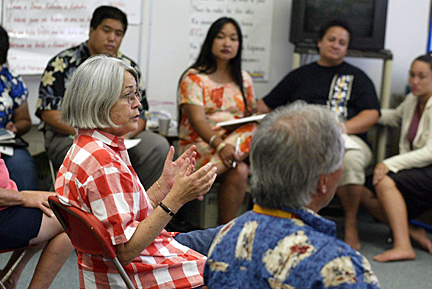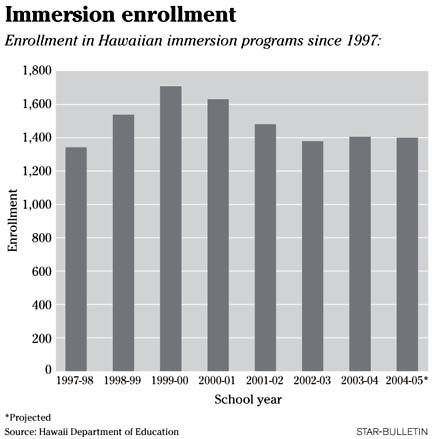

|

Hawaiian schools struggle as students
and staff go to charter sites
The Hawaiian immersion kindergarten class at Puohala School in Kaneohe is less than half of what it used to be. At this time last year, there were 17 children enrolled in the class. This year there are only eight.
The low enrollment at the public elementary school, which started its immersion program in 1990, underscores a widespread trend that has some school officials worried.
School statistics show enrollment in Hawaiian immersion schools peaked in the 1999-2000 school year at 1,700 students and slowly declined before stabilizing at 1,400, this year's projected enrollment. The drop, according to officials, is due to attrition at the intermediate grade levels, low kindergarten enrollment, inability to find licensed teachers proficient in the Hawaiian language to fill positions, and the opening of charter schools. At immersion schools, all subjects are taught in the Hawaiian language and native Hawaiian subject matter is incorporated into the curriculum. English is taught as a separate subject.
Enrollment started to decline in the 2001-02 school year when charter schools, five of which are also Hawaiian immersion schools, opened.
"It wasn't until the charter schools opened that we started seeing the drop," said Keoni Inciong, education specialist with the department's Hawaiian Language Immersion Program.

|
The most likely explanation is that parents are opting for Hawaiian immersion in charter schools, educators say. Charter schools in Hawaii are publicly funded but are free from most laws and regulations except collective bargaining, health and safety, discrimination and federal policies. Schools are held accountable for student performance and funding through a contract, or charter, with the state.
Kalae Akioka, the kindergarten teacher at Puohala Elementary, said she's baffled by the sudden drop in her class and thinks it is largely due to the growing popularity of charter schools.
"This is the first time it's been like this," Akioka, who's been teaching at Puohala for seven years, said. "It can only be because the charter schools are creating competition. It's good that parents have other choices, but it's creating problems."
According to Steve Hirokami, executive director for the Charter School Administrative Office, enrollment in charter schools, including enrollment in each of the five Hawaiian language immersion schools, is the highest it's been since the charter program began in 2000. Overall enrollment in the 27 charter schools has grown to 4,834 for the upcoming school year, from 3,350 in the 2001-2002 school year.
 |
While Puohala is struggling to meet the student quota of 20 for its kindergarten class, Ke Kula O Kamakau, a Hawaiian language charter school also in Kaneohe, has seen its kindergarten class double in size over the past five years. This year, there are 12 children enrolled in kindergarten at Kamakau, the number of students that Puohala needs to register within the next week, or lose a teacher position. Teacher positions are allocated based on student enrollment; if enrollment is too low, the position is pulled.
Hauula Elementary School is also in jeopardy of losing a Hawaiian immersion teacher due to low kindergarten enrollment. The school must raise its kindergarten enrollment to 15 from six by the end of the week.
Makalapua Ka'awa, director of Ke Kula O Kamakau, said that if there is competition between the schools, it's because of circumstances, not strategy.
"We're not trying to be competitive," she said. "But the proximity of the schools has lent itself to that feeling on their part."
The growing popularity of charter schools may have to do with the public school stigma that is attached to a department-sponsored immersion school, Hirokami said. Before charter schools, immersion schools were a welcome option for parents who were unhappy with the public school system's prior inability to perpetuate native Hawaiian language and values.
With the introduction of immersion schools, parents had an option that was preferable to standard public school. Then came charter schools, giving parents the option to send their children to a school that is government funded but incorporates private school qualities like small classes, curriculum flexibility and Hawaiian immersion.
Because charter schools do not intend to keep growing in size, the threat of losing students to the charter schools is not ongoing, Ka'awa said. Neither can they continue to grow in number because the state has capped the number of charter schools allowed to open at 27.
"We are small and we don't plan to get large," Ka'awa said of charter schools. "We left a larger setting to create an intimate, quality program that our parents prefer."
Parents aren't the only ones being drawn to the charter schools.
Inciong said teachers are starting to make the shift as well.
"Last year, we lost immersion teachers to charter schools," Inciong said. "In charter schools, the teaching situation is a lot better. As a teacher, you just want to teach without having to deal with all the bureaucracy that comes with the public system."